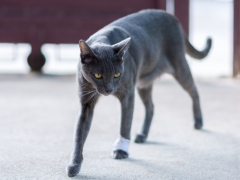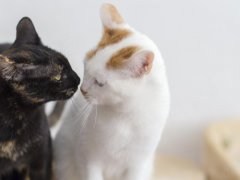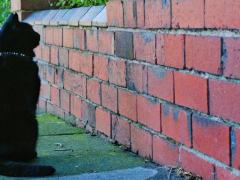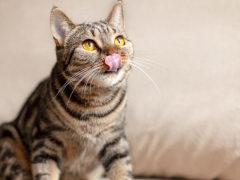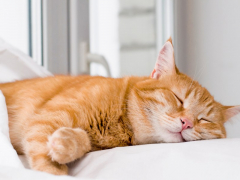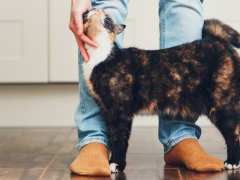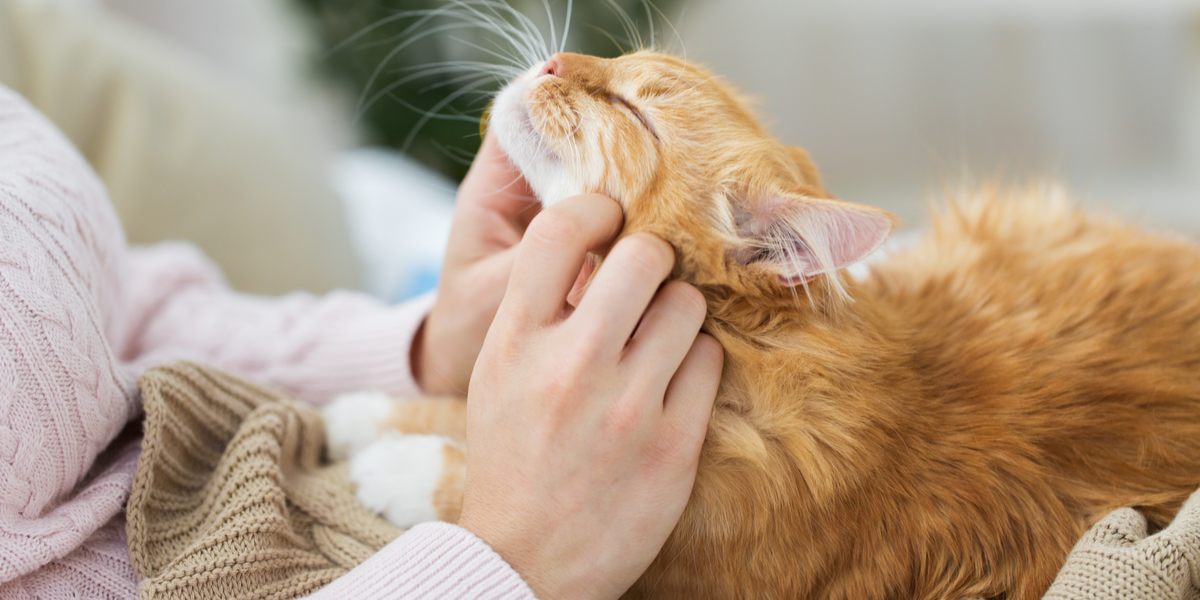
The love and trust a pet bestows upon us is unconditional. Most cats ask little in return. All we must do is provide food and shelter, take care of them, and enrich their environment to make all their natural desires come true.
For many folks, our furry companion is the ‘love’ of our life, with whom we share our daily pleasures and challenges, but how can we know if it’s reciprocated, especially since cats are known to be solitary and enigmatic?
Let’s explore intimately how cats convey ‘love’ and ways to help them to become content around us.
Do Cats Love Us?
Cats are a unique, intelligent, complex species that forms distinct bonds with their owners based on genetics, temperament, early socialization, and former experiences.
Cats don’t feel or display love the exact way humans do, but they’re influenced by positive and negative emotional motivators. A recent study discovered that felines care more about humans and use them as a source of comfort to feel secure once they are distressed.
The devotion a cat feels and shares with their parent can be just as solid as with a dog. Indeed, some moggies even get over-attached to their owners and may suffer separation-related problems.
If a cat chooses to spend time with you, looks forward to seeing you come home, and displays fondness, then the animal is bonded to you!
How Cats Show Love?
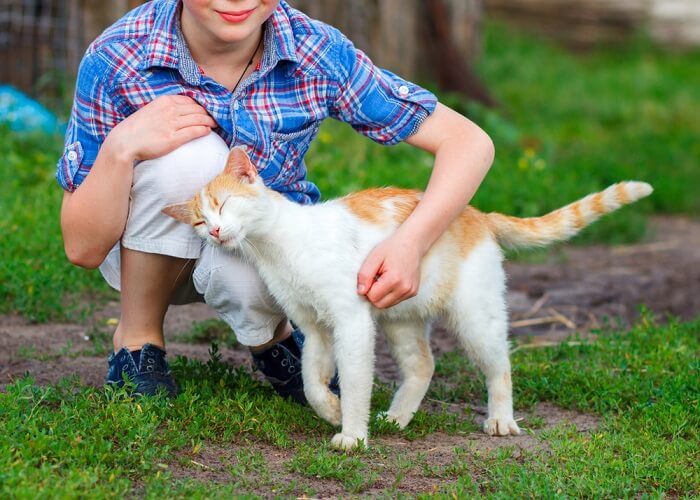
Although cats may show ‘love’ by demonstrating behaviour that can seem peculiar to us, cats are a cautious species and express affection and ease around another human or pet by using multi-sensory modalities (visual combined with olfactory and tactile) to relay diverse meanings.
Generally, body postures and behaviour give an overall impression of the emotional state together with the intention of the cat, whereas facial expressions provide more current info which may be altered rapidly in response to ever-changing situations.
Hence, it’s essential to read postural and variable facial expressions collectively to gain an accurate assessment of how your companion is feeling.
Certain visual signals communicate intent to make distance (hostile signals referred to as distance-increasing signals) while others express the intention to decrease distance (harmonious indications called distance-decreasing signals).
The latter tend to only be directed to those individuals the cat is familiar with and wants to interact with.
Visual signals that a cat would like to decrease the distance from an individual include holding the tail up, social rolling, and slow blinking.
Scientists are now getting down to examine how cats and folks interconnect. Initial research showed that cats can follow people pointing gestures but lack a few of the behaviours dogs display, such as repeated staring at the person whilst purring is used by certain cats to solicit food, attention, and other desires from humans.
They also found that cats answer their owner’s name calling, however don’t respond to strangers who imitate their owner’s call (Heath, 2016).
Based on this research and our understanding of feline communication, we have identified several signs your cat feels comfortable around you.
Signs Your Cat Loves You
Our feline companions signal ‘love’ by displaying a few of the following behaviours:
1. Bunting
Bunting occurs when your cat deposits chemical messages by facial rubbing their cheeks on you, brushing objects, walls, and furniture. Many cats also head-butt their humans with their forehead or brush against their heads.
Depositing of such scent messages conveys territoriality, helps a kitty feel more familiar in their environment, and is related with comfort together with friendly social interactions with someone they love and really do care about their owners.
2. Social Rolling
This behaviour occurs in a number of circumstances, and it’s directed towards people, other cats, and in some situations, to other household pets the cat has a great relationship with.
When a cat is rolling as part of a social interaction with its owner as seen during this video, it transmits a greeting behaviour, communicating friendly intent and invitation to approach.
While it may act as an invite, it’s often misinterpreted as a proposal to touch the belly region, which it’s not, since a cat may get surprised and lash out by biting. We don’t recommend stroking a cat in this area unless your cat enjoys it.
3. Purring
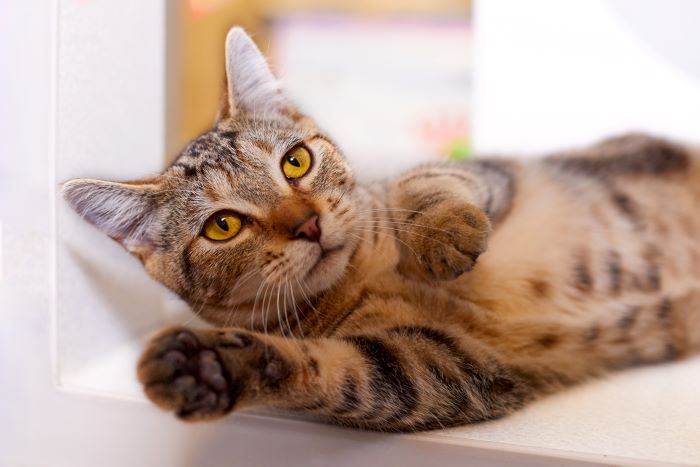
While cats may occasionally also purr to comfort themselves in an unpleasant situation, purring usually indicates a feeling of comfort and wellbeing.
Purring usually communicates some variety of pleasure, presumably contentment.
Cats purr in a number of different contexts considered positive, for instance:
- Kittens purr during nursing, and mothers purr whilst nursing kittens
- When being stroked, talked to, or resting on a person’s lap
- Resting or rubbing against a favoured pet companion
- When being groomed by another cat or person
Purring in positive contexts could also be further reinforced by folks who continue to perform the behaviour that caused the purring as they find listening to purring enjoyable – thus the cat learns that purring causes the favoured behaviour to continue.
It’s worth noting that cats also purr in situations that might be considered negative; when cats are in pain, queens during labour, and while dying.
4. Kneading
Kneading could be a heartwarming behaviour where cats paddle the front paws, usually on a soft surface or the owner’s lap. This behaviour stems from kittenhood when kittens knead mum while feeding to stimulate milk flow.
Kneading persisted into adulthood mostly takes place just before settling down or when your cat is feeling content, relaxed, and adored.
5. Grooming
Cats spend lots of time self-grooming and allogrooming (two cats grooming one another). Similarly, when your cat licks your skin, nibbles your hand, or suckles on clothing, they’re presumably engaging in scent exchange to make a grouping scent, meaning you become a part of their family.
6. Slow Blinking
Eyes are important in signalling moods. A brand-new indicator which is under scientific investigation is known as the slow blink. Slow blink succession usually carries with it a series of half-blinks followed by prolonged eye narrowing or closure.
The slow blink appears to be directed towards humans rather than other cats. It signifies a positive emotional message within which a cat is comfortable with the individual presence or accepts their attention and trust, however it isn’t an invite to come closer necessarily.
To help relax your kitty, respond by blinking slowly in their direction and shift your gaze away to seem non-threatening.
Conclusion
Cats are fascinating species who communicate ‘love’ and devotion in an exceedingly different manner reliant on the context of the situation and owner attachment.
You can reciprocate the love back by observing together with educating yourself regarding felines and admire the differences between us.
Frequently Asked Questions
Do cats get attached to owners?
Although domestic cats conventionally been viewed as unsociable. There’s large body of evidence to suggest that cats are complex individuals capable of forming deep social relationships with humans.
Do cats forget you?
Although there’s insufficient scientific evidence to verify cat’s memory traits, it’s recognised that certain cats can easily adapt to new environments based on previous memory experiences.
Individual relationships with people, intelligence differences, health conditions and age may affect a cat’s memory. Generally, a cat will remember their owner including associated experiences.
Why do cats lick you?
Cats typically lick themselves during grooming sessions whereas queens lick their kittens while nursing. Allogrooming mainly occurs among siblings or cats with a powerful closeness to boost a social bond.
When a cat expresses affiliative social behaviour by licking a person’s hand or face, this kind of scent exchange discloses sign of affection.
Furthermore, cats are emotionally sensitive, tuned in to their owner’s feelings, you’ll find your cat licking you to soothe your anxiety throughout illness or tough times.
Why do cats rub against you?
Usually, when our moggies rub against items, they leave a chemical scent to proclaim the item or area as their territory, it’s theorized that facial rubbing towards humans communicates possible ownership, close social bond and acceptance.
Do Cats Love Us?
If a cat chooses to spend time with you, looks forward to seeing you come home, and displays fondness, then your cat really does love you!
-
Beth Adelman, M. (2018, November 26). Do Cats Love Us? Science Says Yes! Retrieved February 21, 2021, from Fear Free Happy Homes: https://fearfreehappyhomes.com/do-cats-love-us-science-says-yes/
-
Care, I. C. (2020, September 01). Feline Senses and Communication. Advanced Feline Behaviour Course for Vet Professionals. United Kingdom: International Cat Care. Retrieved February 22, 2021
-
Heath, I. R. (2016). Feline Behavioral Health and Welfare. St Louis, MO: Elsevier. Retrieved February 20, 2021
-
Mills, L. S. (2021, January 11). Introducing a Controlled Outdoor Environment Impacts Positively in Cat Welfare and Owner Concerns: The Use of a New Feline Welfare Assessment Tool. (F. i. Science, Compiler) United Kingdom. Retrieved February 22, 2020, from https://www.frontiersin.org/articles/10.3389/fvets.2020.599284/full
-
Tasmin Humphrey, L. P. (2020, October 05). The role of cat eye narrowing movements in cat–human communication. (S. Reports, Compiler) Retrieved February 14, 2020, from https://www.nature.com/articles/s41598-020-73426-0
-
Care, I. C. (2018, October 05). Cat Communication. Retrieved February 17, 2021, from International Cat Care: https://icatcare.org/advice/cat-communication/
-
Halls, V. (2011). Furry babies or felines - do we really know our cats? Retrieved February 18th, 2021 from Vicky Halls: http://www.vickyhalls.net/guides/The%20Cat%20Winter%202011%20-%20Furry%20babies%20or%20felines.pdf
-
Halls, V. (2012). Cats and people – Getting the Relationship Right. UK. Retrieved February 16th, 2021
-
Bradshaw, J. (2013, September 14). More than a feline. (N. Scientist, Compiler) UK. Retrieved February 22, 2021
